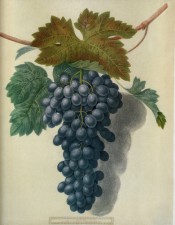Vitis vinifera ‘Black Prince’
‘Bunches rather long, and generally unshouldered; they are, however, occasionally well shouldered. Berries oval, and, when well thinned out, of a very good size. Skin dark blackish purple, covered with a thick blue bloom. Flesh white, abounding with sweet well flavoured Juice. In pulling the berry from the stalk, a long receptacle is left, which is red, and covered with the white flesh. Seeds large, generally four, and sometimes five, in each berry. Leaves rather fleshy, broad in proportion to their length, with long footstalks, tinged with red: the principal lobes not deeply divided, broadly serrated, becoming variegated in the autumn with pale red and dark purple.
The Black Prince is of easy culture, requiring only the protection of the greenhouse or common vinery; and in favourable seasons it will, on a warm dry soil, ripen its fruit on a south wall.’ [George Lindley – Orchard Guide p.195/1831].
Horticultural & Botanical History
‘This Grape will be found deserving the notice of those cultivators whose vinery will admit the growth of various sorts; and it is esteemed by many persons equal, if not superior, to the Black Hamburgh. The author is of the opinion, however, that the latter variety, under skilful management, possesses qualities, which, taken in the aggregate, give it a decided superiority over this and most other grapes. The Black Prince is of easy culture, requiring only the protection of the green house or common vinery; and it will, in favourable seasons, ripen its fruit upon a south wall. The wood is luxuriant, buds large, round; leaves rather fleshy, broad in proportion to their length, the principal lobes not very deeply divided; broadly serrated. Footstalk long, very pale green tinged with red; in decaying the leaves become variegated with pale red and dark purple. The fruit is produced in long bunches, which require much careful thinning; for unless this process be well attended to, the berries will be small and inferior; but when not too many are suffered to remain, these are of rather large size, oval, of a dark blackish purple colour, and covered with a very thick blue meal. The skin is thick, and of rough taste. Flesh white, abounding with sweet and well flavoured juice. In pulling the berry from the stalk, a long receptacle is left, which is red, and covered with the white flesh. Seeds large; generally four, and sometimes five in each berry: the number and size of the seeds, and thickness of the skin, form the most objectionable qualities of this grape; the latter may, however, be considered in some respects an advantage, as it resists the destructive attack of flies.’ [PL vol.1, pl.45/1818].
‘This is, I believe, a Spanish grape, but I have not been able to find out its proper name. It was first met with in the garden of Sir Abraham Pytches, at Streatham, where it attracted the notice of Mr. Malcolm, the nurseryman at Stockwell, and who propagated it for sale under the name of Malcolm's Black Prince.’ [Hogg – Fruit Manual p.376/1884].
Figured in Pomona Britannica [PB pl.LII/1812], the figure used here.
History at Camden Park
Listed in all published catalogues as ‘Black Prince’ [Vines for Table Only no.4/1843].
Notes
Published Jun 23, 2010 - 11:58 AM | Last updated Jul 21, 2011 - 12:46 PM
| Family | Vitaceae |
|---|---|
| Category | |
| Region of origin | Garden origin, unknown |
| Synonyms | |
| Common Name | Grape, Table Grape |
| Name in the Camden Park Record |
Black Prince
|
| Confidence level | high |


